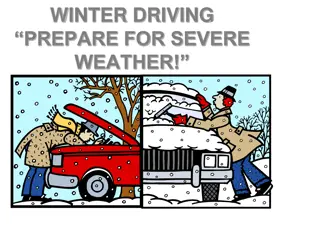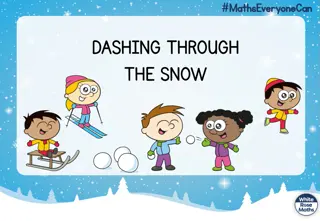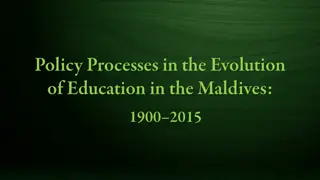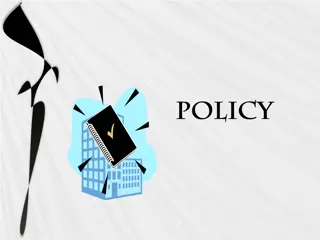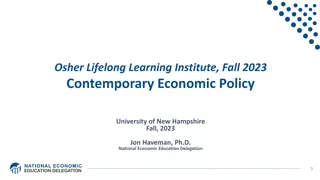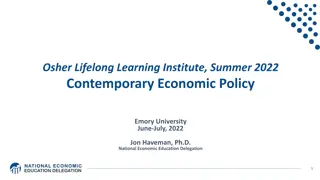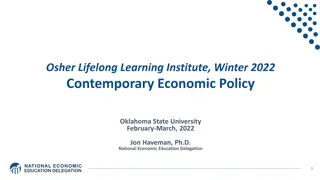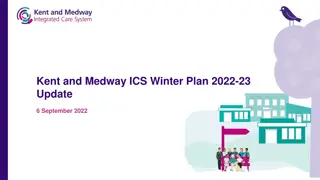Contemporary Economic Policy Winter 2022
In the Winter 2022 session of the Osher Lifelong Learning Institute at the University of Arizona, delve into topics such as US Economy, Coronavirus Economics, Climate Change, Immigration, Trade, Black-White Wealth Gap, and more. Engage with experts in the field and explore the impacts of global trends on economic policies. Be part of an insightful learning experience that delves into the complexities of contemporary economic challenges.
Download Presentation

Please find below an Image/Link to download the presentation.
The content on the website is provided AS IS for your information and personal use only. It may not be sold, licensed, or shared on other websites without obtaining consent from the author.If you encounter any issues during the download, it is possible that the publisher has removed the file from their server.
You are allowed to download the files provided on this website for personal or commercial use, subject to the condition that they are used lawfully. All files are the property of their respective owners.
The content on the website is provided AS IS for your information and personal use only. It may not be sold, licensed, or shared on other websites without obtaining consent from the author.
E N D
Presentation Transcript
Osher Lifelong Learning Institute, Winter 2022 Contemporary Economic Policy University of Arizona January-February, 2022 Host: Jon Haveman, Ph.D. National Economic Education Delegation 1
Available NEED Topics Include: Coronavirus Economics Immigration Economics US Economy Housing Policy Climate Change Federal Budgets Economic Inequality Federal Debt Economic Mobility Black-White Wealth Gap Trade and Globalization Autonomous Vehicles Minimum Wages US Social Policy 2
Course Outline Contemporary Economic Policy - Week 1 (1/27): US Economy & Coronavirus Economics - Week 2 (2/3): Climate Change (Simone Wegge, CUNY, Staten Island) - Week 3 (2/10): Immigration (Roger White, Whittier College) - Week 4 (2/17): Trade (Alan Deardorff, University of Michigan) - Week 5 (2/24): The Black-White Wealth Gap (Me) - Week 6 (3/3): Autonomous Vehicles (Me) 3
Submitting Questions Please submit questions in the chat. - I will try to handle them as they come up, but may take them in a bunch as time permits. We will do a verbal Q&A once the material has been presented. - And the questions in the chat have been addressed. OLLI allowing, we can stay beyond the end of class to have further discussion. 4
Trade and Globalization Alan Deardorff, Ph.D. University of Michigan 5
Trade and Globalization Alan V. Deardorff University of Michigan Presentation to Osher Lifelong Learning Institute University of Arizona February 18, 2022
Outline What is Globalization? Pros and Cons of Trade Trade Policies The Role of Trade Agreements (Effects of the Pandemic) 7
What Globalizations Is Growth over time of many interactions between countries - Trade - Global Value Chains - Foreign Direct Investment - Financial Flows - International Travel - Migration I will focus here on trade 8
Export Volume Worldwide in Billions of US Dollars, 1950-2020 Source: Statista 12
Effects on Economies Supply Chains - Globalization has created long and complex international supply chains
15 NAFTA and the Auto Supply Chain Black, Diamond, and Merrill, One Tiny Widget s Dizzying Journey Shows Just How Critical Nafta Has Become, Bloomberg, February 2, 2017.
16 NAFTA and the Auto Supply Chain Black, Diamond, and Merrill, One Tiny Widget s Dizzying Journey Shows Just How Critical Nafta Has Become, Bloomberg, February 2, 2017.
17 NAFTA and the Auto Supply Chain Black, Diamond, and Merrill, One Tiny Widget s Dizzying Journey Shows Just How Critical Nafta Has Become, Bloomberg, February 2, 2017.
18 NAFTA and the Auto Supply Chain Black, Diamond, and Merrill, One Tiny Widget s Dizzying Journey Shows Just How Critical Nafta Has Become, Bloomberg, February 2, 2017.
19 NAFTA and the Auto Supply Chain Black, Diamond, and Merrill, One Tiny Widget s Dizzying Journey Shows Just How Critical Nafta Has Become, Bloomberg, February 2, 2017.
20 NAFTA and the Auto Supply Chain Black, Diamond, and Merrill, One Tiny Widget s Dizzying Journey Shows Just How Critical Nafta Has Become, Bloomberg, February 2, 2017.
Growth of Global Value Chains, 1970-2015 Source: World Development Report 2020 21
Countries mentioned: China France Italy Japan Malaysia Singapore Spain Vietnam 22 Source: World Development Report 2020
Supply Chains Example: The iPhone assembled in China from parts: Part Come from Accelerometers Germany, the US, South Korea, China, Japan, and Taiwan. Audio chips US, UK, China, South Korea, Taiwan, Japan, and Singapore. Batteries Samsung (South Korea), which has factories in eighty countries. Cameras Qualcomm (US) and Sony (Japan), both with plants in many countries Chips for 3G/4G/LTE networking Qualcomm (US) Compasses AKM Semiconductor (Japan) with plants in the US, France, England, China, South Korea, and Taiwan. Glass screen Corning (US) with plants in twenty-six countries. Gyroscopes Switzerland and many more Source: Krueger 2020, International Trade (What Everyone Needs to Know), p. 254 23
Pros and Cons of Globalization Pros and Cons of Globalization - Gains from Trade oTheory of Comparative Advantage oOther Sources of Gain from Trade - Costs of Trade 25
Gains from Trade Theory of Comparative Advantage
Comparative Advantage The Theory of Comparative Advantage says: - Countries can, by producing o More than they need of what they do relatively best, and o Less than they need of what they do relatively worst - And exporting the extra to other countries in exchange for what they need - All countries can o Get more of everything if that s what they want, and o Gain from trade Illustration with a graph of just 2 countries & 2 goods - (I m eager to know whether this helps you understand.)
Comparative Advantage If US & UK differ in what they can produce US UK Cloth Cloth Food Food
Comparative Advantage Without trade, their consumption will also differ US UK Cloth Cloth Without trade Consumption = Production CB=PB CA=PA Food Food
Comparative Advantage With free trade, they specialize in what they do best US UK Cloth Cloth PB Free Trade Production CB=PB CA=PA PA Food Food
Comparative Advantage And can consume more by trading. US UK Cloth Cloth PB Trade Free Trade Consumption CA CB=PB Trade CA=PA PA Food Food
Comparative Advantage Thus countries both Gain from Trade US UK Cloth Cloth PB Trade Gain from Trade CA CB=PB Trade CA=PA PA Food Food
Generality of Comparative Advantage The Theory of Comparative Advantage requires: - Perfect competition (i.e., all buyers and sellers are very small) - Absence of market distortions (externalities, etc.) o i.e., reasons why supplies and demands don t reflect true costs and benefits The Theory of Comparative Advantage does not require: - Any limit on numbers of goods, factors, and countries - That only final goods are traded (thus consistent with supply chains) - That factors (labor, capital) be immobile between countries o (However, the gains from trade then accrue to countries including their mobile-factor owners.)
Generality of Comparative Advantage But note: - Nothing in the theory says that everyone in each country gains - Opening to trade requires o Some industries to shrink or disappear while others expand o Firms and workers in shrinking industries Certainly lose during the transition May be permanently worse off o In example, losers are producers of Cloth in US Food in UK US UK Cloth Cloth PB CB=PB CA=PA PA Food Food
Gains from Trade Other Sources of Gain from Trade
Other sources of Gain from Trade Productivity (most productive firms expand and export) Returns to scale (small countries can support larger firms) Competition (monopolies in small countries lose market power) Variety (buyers can access more choices) Supply chains (firms can source parts from cheapest or best sources) - (That s really just the above, but within industries and firms.) Technology (producers get access foreign technologies)
But there are Costs Economic: - When trade expands (or contracts) o Some firms lose market share or shut down o Other firms supplying inputs shrink of shut down o Workers in both lose jobs o Their communities lose customers - Macroeconomic cost: Vulnerability to foreign recession/inflation - Dependence on other countries willingness to trade - Vulnerability to trade disruption o Crisis induced (earthquake, flood, disease) o Policy induced (sanctions, tariffs, export bans) Non-economic - Loss of cultural differences - Spread of disease
Pause Pause for -Questions -10-Minute Break Next: Trade Policies 39
Trade Policies that Affect Globalization Policies that Encourage It - Tariff Reductions - Trade Agreements - Other Policies that Discourage It - Trump s Tariffs - Trade War 40
Policies that Encourage Globalization
43 Source: Economist
44 Source: Quartz 2018
Source: WTO 46
European Union 47 Source: Europa.eu
NAFTA (now USMCA) 48
MERCOSUR 49
CPTPP = Trans-Pacific Partnership minus US 50




